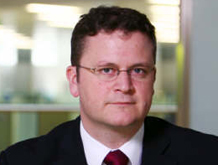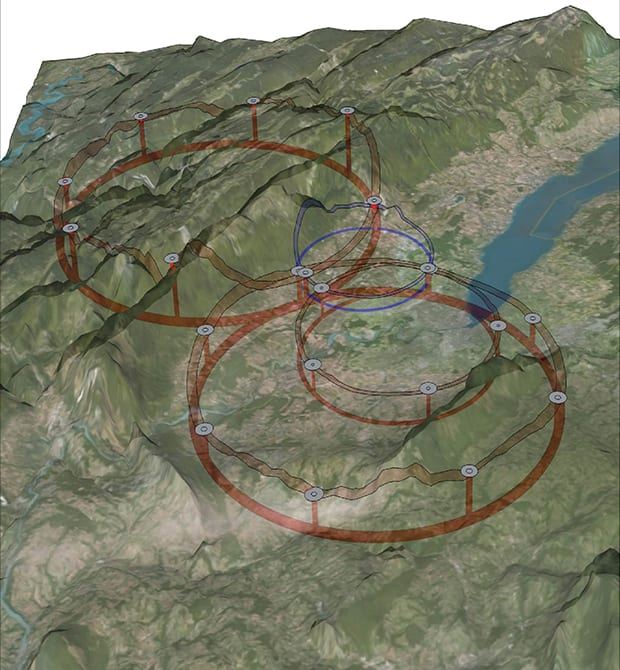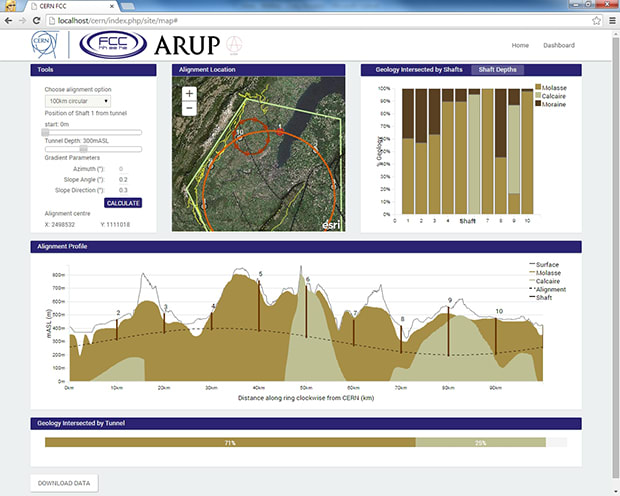Arup has put a BIM model at the heart of a five-year project to plan a new circular “atom smasher” four times the size of Switzerland’s Large Hadron Collider, giving us further insight into the Higgs boson, dark matter and the origins of the universe.
The consultancy was invited in February to advise on the international conceptual design study being carried out by Geneva-based CERN, the European Organisation for Nuclear Research, on a 100km circumference Future Circular Collider (FFC) that will extend the work done at the 27km LHC.
Teams of particle physicists from 21 European countries are collaborating on the development of the FCC, which will use new technologies to accelerate particles to unprecedented speeds.

The issue is physicists communicating with engineers, and engineers communicating with physicists. The final decisions will have to be a balance between the two.– Matt Sykes, Arup

Options for an 80km ring and the existing LHC
Faced with the challenge of integrating the needs of multiple research teams and engineers working with mountainous terrain, Arup has constructed a BIM model to guide decision-making on the performance, cost and risk of the planned facility.
Matt Sykes, Arup project director, said: “The FCC will have to satisfy three different branches of particle physics, and then there’s the small matter of building it. It takes the experiments that found the Higgs boson particle to the next step – if the Large Hadron Collider was a magnifying glass, this will be a microscope. The more detail you require, the higher the energy you need and the larger the ring.”
“The issue is physicists communicating with engineers, and engineers communicating with physicists. The final decisions will have to be a balance between the two.
“So to make the decisions, and make sure it interfaces with the existing tunnels, we decided to capture all the data in a 3D environment. We can change the physical parameters of the project in real time – looking at the geology, the size of the ring, the depth of the shafts, and the slope.” Due to the curvature of the earth, the FCC ring would deflect by 80m over a 100km circumference.
Arup’s BIM model is based on a web-based geographical information system called ESRI which uses open-source code. It combines publicly available data on the geography and geology of the region, with tunnelling calculations and the constraints of building a particle collider system.
Thie data sits behind a “dashboard” (see screenshot) that allows project participants to instantly see the effect of changing parameters. The use of an open-source platform for the BIM model should ensure that “in a long gestation period, you’re not constraining the process unnecessarily,” Sykes says.

The BIM tool dashboard: a user-friendly digital environment with 3D datasets and decision aid tools
Teams located all over Europe can extract a spreadsheet, amend it and upload the revised version. At later stages, further datasets will be overlaid on top of the existing data, and the current, simple 2D visualisations (such as the image of the LHC and FCC options above) would be joined by 3D visualisations.
“You make the most important decisions at the start of the project, so we want to make sure we have all the relevant data to make them. So going straight to BIM means we make those decisions using all the relevant data,” said Sykes.
Arup is working alongside Swiss geotechnical adviser GADZ, the French Geological Society BRGM, and Amberg Engineering.
John Osborne, a civil engineer at Cern, said: “Several layouts for this new machine are under consideration, with the tunnel circumference ranging from 80m to 100m. This tool being developed by Arup will be crucial in the decision making process, to help decide which layout is most feasible.”











